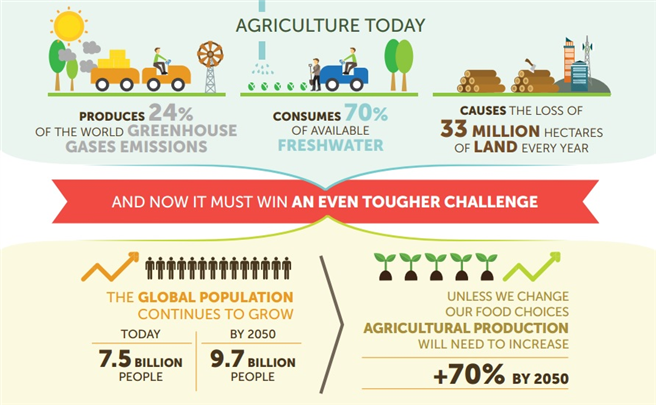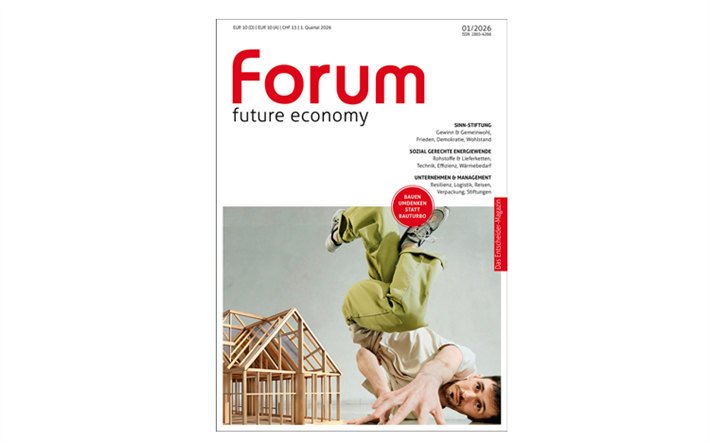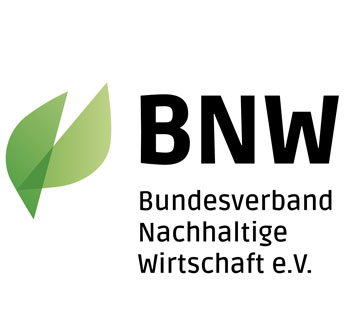Lifestyle | Essen & Trinken, 01.06.2017
Zukunft der nachhaltigen Landwirtschaft trotz internationaler Fortschritte ungewiss
Barilla Foundation plädiert für Investitionen in Nachwuchs und Innovationen
Zum Weltumwelttag am 5. Juni und wenige Tage nach dem G7-Gipfel in Taormina lenkt das Barilla Center for Food and Nutrition (BFCN) die Aufmerksamkeit auf die Wechselwirkungen von Klimawandel und Landwirtschaft. Die Landwirtschaft hat mit 24 Prozent noch immer den größten Anteil an den weltweiten Treibhausgasemissionen.
Lesen Sie hier die vollständige Meldung in englischer Sprache:

- Coinciding with World Environment Day (5 June), and just a few days after the G7 summit in Taormina, the BCFN is shining the spotlight on the impact of agriculture on climate change.
-
30% of greenhouse gas emissions come from food production, compared to 23.6% from heating and 18.5% from transportation. Farming alone produces 24% of global greenhouse gases and uses 70% of the world’s fresh water.
-
Germany, Canada and Japan are front and centre for their sustainable agriculture practices (all on the "podium” at the Food Sustainability Index for this topic), but they’re still behind in terms of the rate of young people and women working in agriculture and the average age of farmers (Germany is 15th, Canada is 18th and Japan is 22nd out of the 25 nations of the Index), factors which are crucial to ensuring sustainable agricultural development in the future.
-
In Europe, there are still many "positives and negatives” related to the number of people under 35 in agriculture: Germany and France are doing better than Spain and Italy, but none of the large countries analysed reached even a 10% share of youths in the industry.
-
The BCFN and the Milan Center for Food Law and Policy have launched the Food Sustainability Report: a quarterly document which aggregates and analyses important global topics related to food and sustainability. To read the Food Sustainability Report, please visit www.foodsustainabilityreport.org
Reconnecting people with nature to save the planet and protect the environment: this is the main goal of this year’s World Environment Day, scheduled for 5 June, coming just a few days after the G7 meeting in Taormina which highlighted the stark contrast in the views of some of the world’s leading countries – including the USA – potentially jeopardising the climate policies approved in Paris during COP21. But where do we begin in tackling the challenge laid down by World Environment Day? To answer the question, we need to specify that, globally, the agricultural sector causes 24% of greenhouse gases (industrial sector reaches 21%, while transportation comes in at 14%). Nearly 40% of the earth’s surface is used for farming and raising animals; the amount of soil on the planet suitable for growing plants is equal to 4.4 billion hectares (a land mass 146 times the size of Italy) and, last but not least, agricultural activities consume 70% of the fresh water that we collect. According to the Food Sustainability Index , Germany (with a score of 65.50 out of 100), Canada (62.35) and Japan (60.56) occupy the top three spots for "sustainable agriculture”, respectively, on the global classification (out of the 25 countries analysed). These three nations, at least for now, seem to be in a good position in terms of the environmental of farming. However, the future is shrouded in doubts and questions, especially in terms of the farmers themselves. Indeed, who will produce our food tomorrow?
This is the very question, and warning, being posed by the Barilla Foundation (BCFN) for World Environment Day. To do so, the BCFN is analysing one of the parameters in the index, "land-users”, which considers three factors that will determine the future of our agricultural system: the percent of women working in agriculture, the percent of young people active in agriculture, and the average age of farmers. These three elements are useful indicators, providing a snapshot of a country’s ability to innovate. As the FAO has shown, young people are on the front lines of innovation across the board, and particularly in this field. Younger generations, thanks to targeted studies and supporting technology, pave new roads in agriculture: from soilless (hydroponic) farming to the use of systems which optimise water consumption, down to precision equipment and drones which monitor plots of land. In this regard, unfortunately, the index is flipped: the 3 countries which were at the top end up at the bottom of the ranking (with Germany 15th, Canada 18th and Japan 22nd out of the 25 nations analysed). This places them behind Brazil (82.68 points out of 100, almost triple that of Japan’s score in this category, 30.39 points), various emerging economies, and even after leading economies such as Israel (5th with 58.85 points out of 100) and Australia (11th with 49.63 points out of 100). The message being sent by the BCFN, upon reading and analysing the FSI, is clear: in order not to fall behind, agriculture needs to change. For this to happen, young people must lead the way in terms of innovation, the use of new technology and the digitisation of the industry.
Europe: Germany, France and Italy's positives and negatives in the agricultural system
The data from Nomisma confirms the worrying statistics highlighted by the Food Sustainability Index: in Italy only 5.1% of those working in the farming industry are under 35 (82,000 in all), while a solid 37.2% are over 65 (603,390). Such demographics are even more disheartening when compared to other large countries on the old continent, where farmers under 35 in Germany (7.1%), France (8.7%) and Spain (5.3%) are more numerous. Over-65 farmers, on the other hand, are just 12% in France, while in Germany they stand at 5.3%. In terms of generational change, comparing agricultural entrepreneurs under 35 years of age with those who are over 65, the ratio comes to 73% in France, in Germany it exceeds 100% (at an impressive 134%), while in Italy it stops at a relatively small 14% (14 youths for every 100 from the older generations). In Europe, the contrast on the topic even extends into the total utilised agricultural area (UAA) of young farmers: in Germany, it’s 49 hectares and in France it rises to 68.5, while in Italy it’s an insignificant 13.6 hectares. Even the economic impact of agricultural businesses seems to echo this trend among large European nations, with Italian farms among the most restrained at less than €55,000 for standard yields, a number which is practically doubled in France (€118,403) and Germany (€130,369) . All of this data on large nations in the EU accent Europe’s "risk of not innovating”, affecting a sector which has deep environmental impact and which should be investing heavily in new ideas.
Marta Antonelli, Research Programme Manager at the Barilla Center for Food and Nutrition Foundation, stressed the importance of generational change in Europe and the need to support it through EU-wide legislative tools: "We need to create a Common Agricultural Policy (CAP) which can shape a truly fair, healthy and sustainable food system, putting young farmers at the centre of this change. To reach this goal, the CAP neds to be modernised; it needs to integrate agriculture and healthier, more sustainable nutritional guidelines, along with economic sustainability and food security. The CAP should support farmers in being responsible for the provision of healthy, sustainable food at reasonable prices, while also taking care of the environment in rural areas. This is precisely why environmental considerations should be a priority in the decision-making process, for example, through "payment for eco system services”, incentives which stimulate business diversification and the maintenance of the land being used. Farmers should thus be thought of not just as food producers, but also as guardians of our environment.”
Women and Agriculture: Globally, nearly half of all farmers are women
Another important aspect considered by the "land-users” parameter of the Food Sustainability Index is the number of women in agriculture. To get an idea of how important this is, just think that by 2050, the earth’s population will exceed nine billion people and that we will need to further increase food production by 70% to feed everyone (as estimated by the FAO). For this reason, as the FAO has shown , we’ll also need a sizeable workforce which includes women. According to the most recent data available, women make up 43% of the workforce in jobs related to agriculture and they produce 70% of the food resources available (in Africa that number reaches 80%). In short, it would be quite difficult to feed the current global population without women. Yet, as explained by Danielle Nierenberg, Food Tank President and member of the BCFN Advisory Board, "It is essential for women to be recognised for their role as ‘wealth producers’, reinforcing, especially in rural areas, the network of public services such as healthcare, education and social services. In many countries, the quality of life of female food producers is very low and this can have an impact on the sustainability of the model over the long term.” This warning mustn’t be undervalued, because in absolute terms, although there are more men than women in the field, in rural societies the latter spend more time tending to the crops which feed the family and to that which actually generates a profit. At the root of discrimination against women in agriculture, specific aspects must be changed. For example, in many parts of the world women cannot own the land they work or they don’t have the right to use it long-term, or they have problems getting agricultural credit or accessing weather and temperature stats, which effectively exposes them to greater risks related to climate change. Yet overcoming such discrimination would significantly help resolve the issue of female unemployment.
The issues of female employment, climate change and food production in the face of global demographic growth have become even more topical given the recent G7 summit and the USA’s possible renegotiation of the Paris agreements. As a result of climate change, we are faced with a hugely serious drought which is devastating harvests and decimating water reserves: 13 million people are already on the brink of famine. This is why it is crucial to continue in the direction marked out in Paris, both by avoiding actions which would contribute to further climate change, and by focusing on women and young people to strive for innovation in the agricultural sector and limit the impact our food choices have on climate change.
800 million people around the globe participate in urban farming
Among the best practices which have taken root in recent years and which touch upon "Connecting People to Nature” as hoped for on World Environment Day, is the growing phenomenon of urban farming. According to the FAO, urban farming (spaces available to the community where people can freely grow fruits and vegetables, contributing to food security and strengthening social cohesion) involves 800 million people globally and seems to be on the rise. A few examples from around the world? In Paris there’s the Green Hand Charter (Charte Main Verte), a community initiative which helped create 130 gardens and which offers anyone who’s interested the chance to plant cultivatable vegetable plots and gardens in urban soil, with the collaboration and support of local authorities.
In Berlin, there’s a farm thriving alongside a strip of the old wall, amid out-of-commission metro stops, graffiti and buildings past their prime. Within each plot, people are growing a wide array of vegetables, all planted in containers which are easy to move and made out of reused materials, such as recycled Tetra Paks, rice bags and plastic boxes, allowing them to be rearranged effortlessly. Visitors can pick vegetables, learn more about seed and vegetable harvesting, or visit the café to enjoy snacks made with crops from the garden.
Urban farms can be even be carved out from abandoned spaces, helping rethink urban areas which otherwise would end up abandoned and forgotten. This is being seen, once again, in Berlin, where courgettes, tomatoes and Brussels sprouts are harvested from the 300 plots set up on the former landing strip of the Tempelhof airport, closed in 2009. Or in Yokosuka, Japan, just 40 Km from Tokyo, where produce is being grown in a former floppy disk factory that Toshiba has transformed into a vertical hydroponic farm.
The Food Sustainability Report, a new tool kit to talk about food and environmental impact
The Barilla Center for Food and Nutrition Foundation (BCFN) and the Milan Center for Food Law and Policy have launched the Food Sustainability Report, a constantly-updated tool to present complex topics related to food in order to raise awareness among government bureaus, institutions and the public about the urgent need to take action and make the global food system truly sustainable.
Of the topics analysed in the first issue, people are also talking about defending biodiversity. More specifically, their attention is focused on the EU commission’s "Natura 2000” project. This ecological network is present in nearly 1/5 of the European Union, established to ensure the long-term survival of nearly one thousand threatened animal and plant species, and natural habitats.
Released quarterly, the Food Sustainability Report arose from constant analysis of the news and documents on food and sustainability published online by the main English-language sources, including information websites as well as those of international agencies, NGOs and research institutes. It is a snapshot of the quantity, prevailing content and current trends in research, legal policy and concrete actions already under way, taken through data reflecting the volume of information available, semantic analysis of topics getting the most attention, and the signalling of news reports, documents and research papers to read, consider and highlight. In short, the report is an aid for experts to navigate the flood of information about food and its impact on our society, the economy and the environment, offering insights as to how, and the extent which, these dynamics impact our daily lives and the fragile balance of the very complex food system.
The first issue is available online at www.foodsustainabilityreport.org; the second issue of the report will be released in mid-July.
Kontakt: www.barillacfn.com

forum future economy
forum Nachhaltig Wirtschaften heißt jetzt forum future economy.
- Mit diesem Schritt markiert der Verlag bewusst eine Zeitenwende – hin zu einer Wirtschaft, die Zukunft schafft, statt nur Probleme zu verwalten.
Kaufen...
Abonnieren...
08
DEZ
2025
DEZ
2025
09
DEZ
2025
DEZ
2025
Club of Rome Salon: Building the City of the Future (in English)
Cities, World Expos, and Stakeholders Driving Sustainability
10178 Berlin
Cities, World Expos, and Stakeholders Driving Sustainability
10178 Berlin
Anzeige

Professionelle Klimabilanz, einfach selbst gemacht

Einfache Klimabilanzierung und glaubhafte Nachhaltigkeitskommunikation gemäß GHG-Protocol
Megatrends
 Wohlstandsverlust - und die Angst vor Veränderung
Wohlstandsverlust - und die Angst vor VeränderungChristoph Quarch stellt die Frage, welche Art von Wohlstand wir wirklich brauchen
Jetzt auf forum:
Ökologische Stromproduktion aus Fließgewässern
Ab 14.12.2025 gilt der neue Fahrplan der Deutschen Bahn für 2026
Schulen stärken Bildung für nachhaltige Entwicklung
Seit 15 Jahren: faire und umweltbewusste Beschaffung mit dem Kompass Nachhaltigkeit















